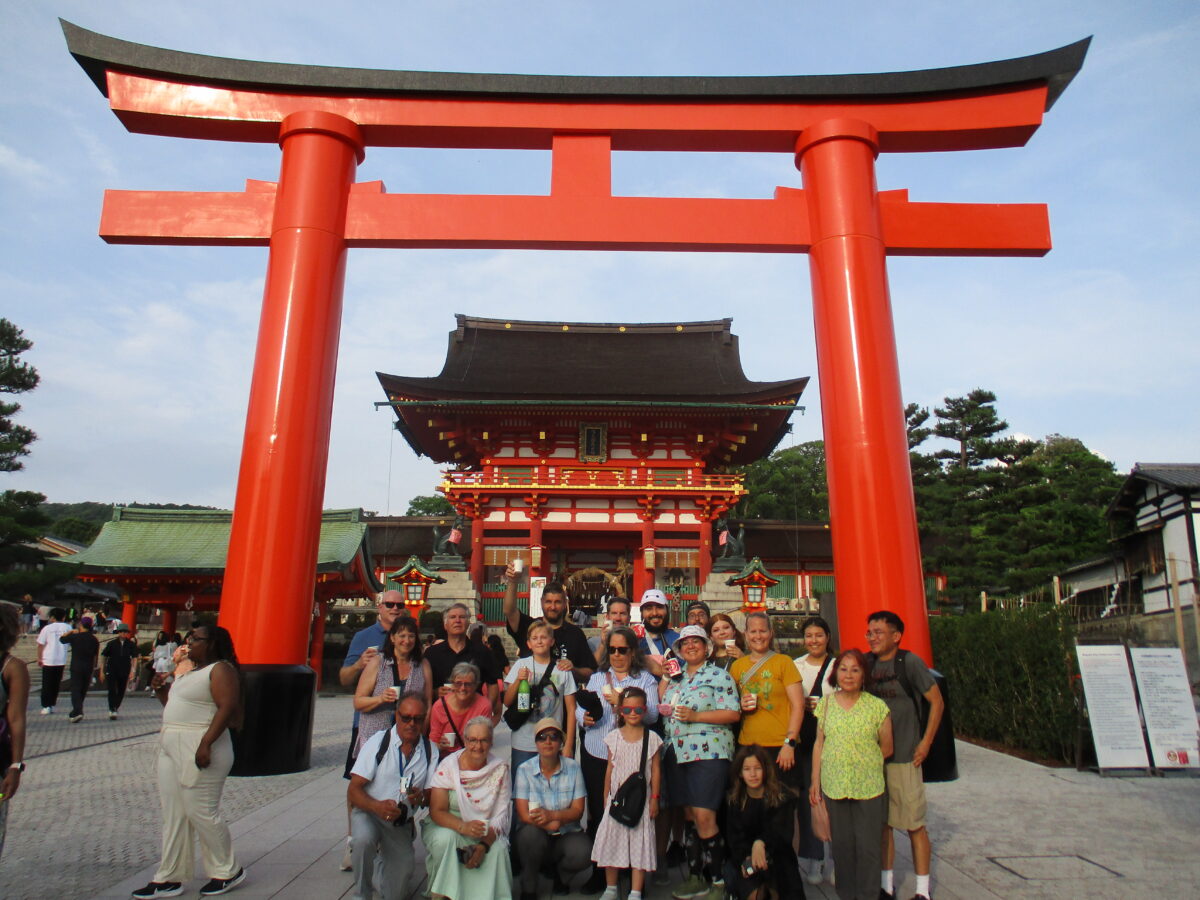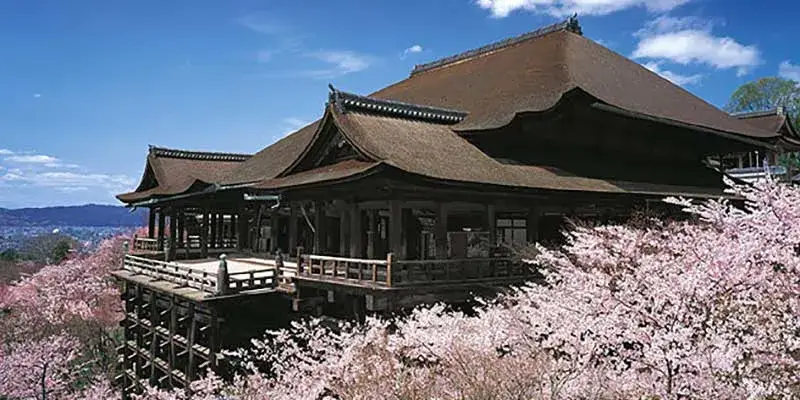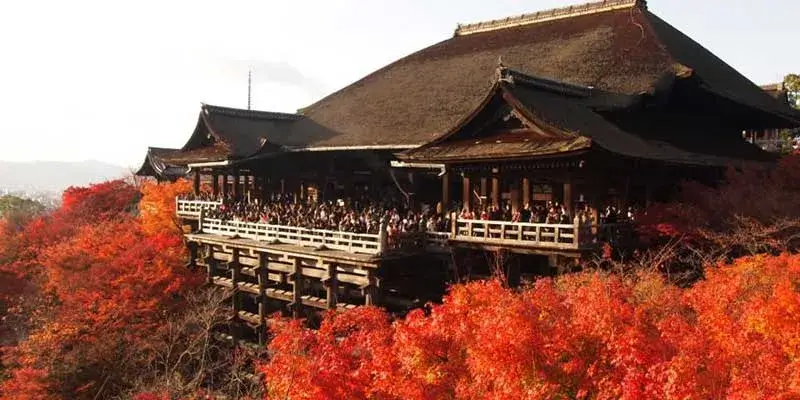
What is Kiyomizu-dera?
Kiyomizu-dera (清水寺) is one of Kyoto’s most iconic temples, visited by millions each year for its panoramic views, dramatic wooden stage, and sacred atmosphere. Founded over 1,200 years ago, this UNESCO World Heritage Site is perched on the hills of Higashiyama and offers a sweeping view of Kyoto city.
The name “Kiyomizu” means “pure water” and refers to the Otowa Waterfall that flows beneath the main hall. This temple is dedicated to Kannon, the goddess of compassion, and has been a pilgrimage site for centuries. Visitors come not only for its spiritual significance but also to enjoy seasonal scenery, especially during cherry blossom and autumn foliage seasons.
Kiyomizu-dera is also known for its unique architecture: the main hall (Hondo) is built without a single nail and supported by tall wooden pillars above the hillside. Whether you’re here for spiritual reasons, cultural exploration, or photography, this temple is a must-visit highlight of Kyoto.
History and Religious Significance

Kiyomizu-dera was founded in 778 during the Nara period, making it one of the oldest temples in Kyoto. Its roots are tied to the monk Enchin, who was guided to the site by a vision and discovered the sacred Otowa Waterfall. Soon after, a temple was established and dedicated to Kannon, the Bodhisattva of Mercy.
The temple complex flourished under imperial patronage and has long been revered as a sacred site for Kannon worship. Over the centuries, Kiyomizu-dera endured multiple fires and reconstructions. The present buildings date back to 1633, rebuilt by order of Tokugawa Iemitsu, the third shogun of the Tokugawa dynasty.
One of the temple’s most famous features is its wooden stage, or “Kiyomizu Stage,” which extends out from the main hall, 13 meters above the hillside. The structure is built using traditional Japanese techniques without nails and offers a spectacular panoramic view of the city and surrounding forested slopes.
The temple’s long-standing connection to Kannon reflects the enduring values of mercy, healing, and spiritual salvation. For centuries, pilgrims have come here to pray for personal blessings, health, and romantic success. This deep religious resonance still permeates the temple today.
Temple Highlights – What to See at Kiyomizu-dera

Main Hall (Hondō) and the Wooden Stage
This is the heart of Kiyomizu-dera and home to the temple’s principal deity, the Eleven-Faced Kannon Bodhisattva.
The iconic wooden stage, built without nails, juts out over the hillside and offers sweeping views of Kyoto. During cherry blossom and autumn foliage seasons, the scenery is breathtaking.
Otowa Waterfall
Located just below the main hall, this sacred spring is the source of the temple’s name—“Kiyomizu” means “pure water.”
Visitors can drink from three separate streams said to grant success in love, academic achievement, and long life. But be warned—drinking from all three is considered greedy!
Jishu Shrine
A small shrine behind the main hall, dedicated to the deity of love and matchmaking.
Test your romantic fate by walking with eyes closed between two “love stones” placed 18 meters apart. If you reach the other stone unaided, your wish for love may come true.
Okunoin Hall
Just uphill from the main stage, this smaller hall has its own elevated wooden terrace, offering a perfect vantage point to admire the main hall from a distance.
It’s one of the best photo spots in the entire complex.
Zuigu Hall & Tainai Meguri
This hall enshrines Daizuigu Bosatsu, a hidden Buddha associated with childbirth and wishes.
Inside, you can experience the symbolic “womb journey” of Tainai Meguri—a pitch-black corridor representing rebirth and introspection.
Jojuin and the Moon Garden (Limited Opening)
Originally the residence of a head priest, Jojuin is famous for its exquisitely landscaped Moon Garden, designed to reflect the moonlight.
The garden is only open to the public during special viewing periods in spring and autumn.
How to Get There – Access to Kiyomizu-dera
Address
Kiyomizu-dera Temple
1-294 Kiyomizu, Higashiyama Ward, Kyoto, 605-0862, Japan
From Kiyomizu-Gojo Station (Keihan Line)
- Walk about 20 minutes uphill through Gojo-zaka or Chawan-zaka streets.
- These roads are lined with souvenir shops and sweet stores—perfect for a slow stroll.
From Kyoto Station
- Take bus #100 or #206 to Gojo-zaka (五条坂) or Kiyomizu-michi (清水道) bus stop.
- Walk about 10 minutes uphill to the temple gate.
Pro Tips
- The paths to the temple are steep and cobbled—wear comfortable shoes.
- Early mornings or late afternoons are best to avoid crowds.
- Try approaching via Sanneizaka (Sannenzaka) and Ninenzaka—two preserved streets offering a more scenic route.
Q&A – Kiyomizu-dera Travel Tips
Why is Kiyomizu-dera so famous?
Kiyomizu-dera is one of Kyoto’s most iconic temples, known for its massive wooden stage that juts out over the hillside, offering sweeping views of the city—especially stunning during cherry blossom and autumn foliage seasons. Its long history (over 1,200 years), UNESCO World Heritage status, and spiritual significance draw millions of visitors each year.
Do you drink the water at Kiyomizu-dera?
Yes. Visitors drink from the Otowa Waterfall at the base of the main hall. There are three separate streams, and each one is believed to offer different blessings: academic success, love, or longevity. It’s customary to choose just one to avoid appearing greedy.
Is Kiyomizu-dera better at night?
Kiyomizu-dera is especially magical during special evening light-up events in spring, summer, and autumn. The temple buildings and trees are illuminated, creating a serene and otherworldly atmosphere. Check the official website for seasonal lighting dates.
What does Kiyomizu mean in Japanese?
“Kiyomizu” (清水) means “pure water.” The name comes from the Otowa Waterfall on the temple grounds, which is the source of the temple’s founding legend and spiritual significance.
How long do you need at Kiyomizu-dera?
Most visitors spend 1 to 2 hours exploring the temple buildings, walking the scenic routes, and enjoying the nearby shops and tea houses. If you plan to explore surrounding areas like Ninenzaka or Maruyama Park, give yourself more time.
Visitor Info – Kiyomizu-dera
Location
Kiyomizu-dera Temple
1-294 Kiyomizu, Higashiyama Ward, Kyoto, 605-0862
Official Website: https://www.kiyomizudera.or.jp/en/
Opening Hours
- 6:00 AM – 6:00 PM (extended to 9:30 PM during seasonal light-ups)
Admission
- Adults: ¥400
- Children: ¥200
Access
- From Kyoto Station: Take bus #100 or #206 to Gojo-zaka or Kiyomizu-michi stop, then walk 10 minutes uphill
- From Gion/Shijo: A 20-minute walk east through historic streets like Sannenzaka and Ninenzaka
Language Support & Facilities
- Basic English signage available throughout the grounds
- Souvenir shop and restrooms on site
- Wheelchair-accessible path available via the side entrance (though some areas are steep)
Best Times to Visit
- Spring and autumn for cherry blossoms and foliage
- Early mornings for fewer crowds
- Evening light-up events during special seasons
Last updated: December 2025